
MINOLTA 35mm RANGEFINDER AND VIEWFINDER CAMERAS

All of these cameras used 35mm film, but the formats varied from full-frame down to half-frame with several in-between. Interestingly, like many of Minolta's cameras -- even in other film formats -- not all of them bore the Minolta name. Some were sold by GAF, some by Revue, some by Ansco -- and probably others as well. They are included here, but there may be some missing.
If you are able to provide more accurate information than is listed here, please contact us.

(1947) After the War, Japanese copies of the expensive, German Leica screwmount camera were very popular. Minolta jumped on the Leica bandwagon with the Minolta 35 camera. That's what it was called, and this made some sense since it was the only Minolta camera -- at that time -- to use 35mm film. It has a 45mm (f2.8) lens with an interchangeable lens mount with 39mm x 1mm screw-mount. This was an exact copy of the Leica screwmount thread. What sets this camera apart from the other Leica copies of the time is that it is the first Japanese camera to be fitted with a hot shoe and self-timer! Hard to believe, but true. The unusual 24x32mm image size was actually standard for Japan -- at that time. It saved film and matched the 8x10 format more closely than 24x36mm. It has shutter speeds of 1 - 1/500 plus B and T and interchangeable lenses were available. Like the Leica, shutter speeds were selected with two dial -- the faster speeds were selected on the main dial on the top of the camera, while the slower speeds required rotating the main dial as well as the slow-speed selector on the front of the camera. The Minolta 35 was always being modified and should be thought of as a stream of cameras instead of just one. The model number is not inscribed on the early camera models.
(1948) Within a few months, Minolta made some minor changes to the camera, but it is virtually indistinguishable from the previous model. The model number is not inscribed on the camera. It used the same standard 45mm (f2.8) lens with an interchangeable lens mount with 39mm x 1mm screw-mount. (Leica thread). Image size increased to 24x33mm. Interchangeable lenses were available.
(1948) Later in the same year, Minolta made some more minor changes to the camera, but again, it is virtually indistinguishable from the previous model. On the previous model, on the slow speed selector (on the front of the camera), the speeds read out, away from the camera body. This meant that you had to turn the camera around to set these speeds. On this model, the speeds face the photographer, and are easier to set. It used the same standard 45mm (f2.8) lens with an interchangeable lens mount with 39mm x 1mm screw-mount. (Leica thread). Image size increased again to 24x34mm. Interchangeable lenses were available.

The year 1949 was a banner year for Minolta, and it marked an interesting turning point for the company. On many of the earliest Minolta cameras, the lenses were not made by Minolta, but rather by other firms, typically Asahi -- the largest glass maker in Japan. Finally, in 1940, Minolta was able to start producing some of its own optics, and the Rokkor brand was born. By 1949, Minolta was in a position to turn the tables around, and started making lenses for other camera companies. Frequently, these non-Minolta cameras had lenses that were marked "ROKKOR". One of these cameras was the Look Model A. The body of the Look Model A was not made by Minolta, but by the Look Camera Company. However, the Look Model A is normally seen with a Minolta Rokkor 45mm lens. The Look Model A is a Leica copy, which were fairly common in the late forties and early fifties. Minolta had been making Leica copies since 1947, so their Rokkor 45mm was perfectly usable on other Leica copies, such as the Look Model A. But I guess that the Look Model A couldn't compete with the other Leica copies from other manufacturers -- because a Look Model B was never made.
(1949) Later in the same year, Minolta again made some minor changes to the camera, but it is virtually indistinguishable from the previous model. The addition of lugs for a camera strap is the obvious give-away, but an indentation was added, just below the lens, to make lens removal easier. It used the same standard 45mm (f2.8) lens with an interchangeable lens mount with 39mm x 1mm screw-mount. (Leica thread). Minor body changes. Image size of 24x34mm. Interchangeable lenses were available.
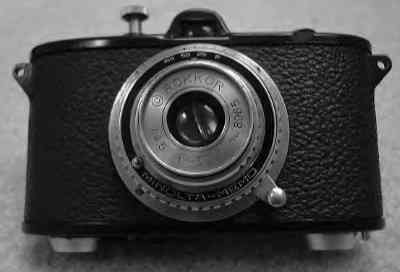
(1949) 50mm (f4.5) lens. Speeds of 1/25 - 1/100, plus B. An inexpensive, simple, bakelite camera, this was Minolta's attempt to get into the inexpensive camera market after WWII. Still, the Memo is not a toy like many of the other cheap cameras of the era. Despite it's simple viewfinder, it has fairly complete features drawn from Minolta's other cameras. It sported a new "quick, film advance lever" on the bottom of the camera -- something we take for granted today -- at a time when all the other cameras used knobs to advance the film. Not too many were made -- perhaps 10,000 -- and the cheap, brittle bakelite body has reduced this number substantially. Many of the remaining samples are seen with broken film advance levers.

(1951) Once again, Minolta made some minor changes to the camera, but it is virtually indistinguishable from the previous model. Some have a diopter adjustment on the viewfinder and most are marked with "Model E". It used the same standard 45mm (f2.8) lens. Has interchangeable lens mount with M39X1 screw-mounts (Leica thread). Image size of 24x34mm. Interchangeable lenses were available.

(1952) Once again, Minolta made some minor changes to the camera, but it is virtually indistinguishable from the previous model. Probably all are marked "Model F". It used the same standard 45mm (f2.8) lens. Has interchangeable lens mount with M39X1 screw-mounts (Leica thread). Image size of 24x34mm. Interchangeable lenses were available.
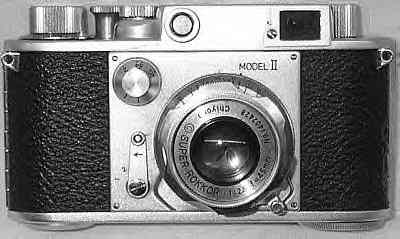
(1953) Very similar to the Minolta 35. Marked "Model II" on the front, but the model is not marked. Same interchangeable lens mount. Sold with a 45mm (f2.8) lens. Shutter speeds of 1 - 1/500 plus B and T. The hot shoe is gone for some reason. Image size of 24x34mm. Interchangeable lenses were available.

(1955) The Minolta A was a family of cameras that lasted for five years. These cameras tried several new features in an attempt to make things easier for the consumer. The original (1955) has a non-interchangeable 45mm (f3.5) lens with rangefinder focusing. This was the first Japanese camera to employ a new, simplified aperture scale. Instead of normal f-numbers, it used a straight linear scale. Speeds of B, 1/2 - 1/200, set by the unique, rotating dial on the top of the camera instead of those infernal little rings around the lens. This intelligent approach would be used on later Minolta cameras, and was not just designed to make it easy for the user's fingers. If a meter is attached to the top of the camera, the meter can be coupled to the dial and it can "automatically" change the shutter speed dial as the meter reading is taken! This approach was destined to be used later Minolta SLR cameras, such as the SR-3, while other SLR cameras, such as the Olympus OM-1 and the Nikkormat FT's opted to keep the shutter speed dial around the lens. The back on the A was removable. But there are at least two later versions of this camera with speeds of B, 1 - 1/300. At some point they switched back to a normal f-stop scale, and some of these had a non-removable, hinged back.

(1956) Updated version of the Minolta 35 II (model a). The top plate on the camera is changed slightly. The edges are less round and the shutter speed dial is on a wider plate. The features stayed the same, but the camera was sold with a new, faster 50mm (f2.0) lens. Shutter speeds of 1 - 1/500 plus B and T. Image size of 24x34mm. Interchangeable lenses were available.

(1956) This camera was an improved version of the Minolta A. It came with a non-interchangeable lens, but it was available in two models -- however the model name was not used by Minolta. It is only used here to distinguish the two. They were exactly the same camera (and sold at the same time) except for two important details. The less expensive version -- here called the "model a" -- has a 45mm f3.5 lens, and an Optiper shutter with speeds of B, 1 - 1/400. Besides the slight shutter increase, the main difference from the original Minolta A is a viewfinder that shifts with focus -- parallax correcting.. This is why is it now has a long, narrow window on the front.

(1956) This version of the Minolta A-2 has a slightly faster 45mm f2.8 lens, and a slightly faster Citizen shutter with speeds of B, 1 - 1/500. There is also a tiny change to the built-in depth-of-field scale (due to the f2.8 aperture) -- and the price tag, of course!

(1957) As mentioned above, after the war, Japanese copies of the Leica screwmount camera were very common, and sold quite well. Perhaps this is one reason that Leica developed the M3 camera in 1954 -- a new 35mm rangefinder with a new bayonet lens mount called the M-mount (named after the camera). Since Minolta had been selling copies of the Leica screwmount camera -- with modifications and improvements -- they decided to do the same thing with the new Leica M3. The new camera was to be called the Minolta Sky, and it was planned to be unveiled in 1957. But, for some reason, it never made it to market. The Sky definitely looks and operates like the Leica M3, and it has several advantages. It was to be sold with a new, super-fast 50mm (f1.4) lens using the new Leica M-mount. There's much speculation as to what went wrong, and we may never know the full story. Some suggest that Minolta decided to put their energies into SLR cameras, like the SR-2 of 1958, but Minolta continued to make top-end rangefinder cameras. What's more likely is that Leica prohibited the use of the M mount -- in one way or another. In any event, Minolta dropped the Sky, and Leica went on to make a highly successful camera without any significant competition.

(1957) The Minolta Super A was a super-improved version of the Minolta A. Just calling it a "Minolta B" wasn't adequate. The main difference was that the camera now has interchangeable lenses -- with an exclusive breech mount . Lenses were available from 35mm to 135mm -- with rangefinder focusing, too. There were three standard lenses, all 50mm: f1.8, f2.0, and f2.8. In addition, there was one wide-angle (35mm f3.5), and three telephoto -- 85mm f2.8, 100mm f3.8, 135mm f4.5 (each with matched bright-frame accessory finders). All of the lenses couple to the superimposed rangefinder. Speeds of B, 1 - 1/400. An accessory selenium meter fits into the flash shoe and couples with the shutter wheel on the top of the camera. This provides metered-manual exposure control -- the first Japanese camera to have this feature. You dial in the film speed into the meter and then select the f-stop on the lens. Then, on the meter, you match the needle to the same f-stop and the correct shutter speed is "automatically" selected. There was even a meter booster which fit on top of the meter for low-light situations!

(1958) Similar to the Minolta II (model b) but with a new, faster 50mm (f1.8) lens. Perhaps more importantly, the image size was finally increased to 24x36mm -- from 24x34mm. In addition, the film advance knob was replaced by a winding lever. Interchangeable lenses were available.

(1958) More commonly referred to as the A2 LT, the A2 L looks and operates like the A2 -- in fact, it is labeled A2 on the top. What's the difference? The A2 did not have interchangeable lenses. The A2 L, like the Super A, did. It does not use a Leica Thread, as some earlier Minolta 35mm cameras did. The "LT" suggests that it did, but it has a unique 24mm screw mount instead -- and was supplied with a 45mm f2.8 lens. Only one other lens was ever produced -- the 100mm f4.8 LT lens. Unlike the original A2, the A2 L only came with one shutter -- the 1/500s. The fact that it was sold at the same time as the original, less expensive A2, and the more versatile Super A (with a selection of interchangeable lenses) explains its short sales life -- and some of the confusion. You can tell the A2 and the A2 L apart, because the A2 L has a "tab" or "pole" that sticks out under the PC connection for use with the 100mm LT lens (below).

For reasons I won't take the time to explain, the Minolta A2 L camera is, more often than not, referred to as the Minolta A2 LT (above) by mistake. The "T" refers to this 100mm telephoto lens for the A2 L.
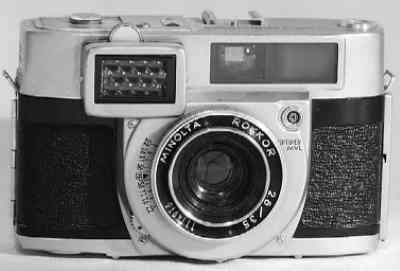
(1958) Another Minolta first -- this was Japan's first camera with a built-in, coupled meter! And to keep it compact it has a small, short, wide 35mm (f2.8) lens. This was the first Japanese camera to have a fully-integrated, internal, metered-manual exposure system. At the time it was called "semi-automatic" exposure. Basically it is a match needle system with the aperture and shutter speed dials aligning the needles. Two versions exist. The earlier version has a exposure value (EV) scale on the coupled meter read-out. Scale focus with P/G/S click-stops for portrait, group, and scene. Optiper MVL shutter (1-1/500, B). Bottom wind. A dual-action dial on the back sets the aperture and shutter speed, but can be rotated together to change settings without changing the EV.

(1958) The late 1950's saw incredible competition in rangefinder cameras. Everyone was looking to find some way to make their new camera stand out from the "pack". So Minolta decided to make a camera with the world's faster shutter speed. The blades of the aperture and shutter were specially coordinated on this camera. At the top speed, the aperture only opens part-way -- to a maximum of f8. This is a more complicated operation, but allows for super fast speeds since the shutter only has to open a tiny bit to make a small aperture, like f8. This approach produced a real speed demon at the time. Not only did it come with a fast 45mm (f2.0) lens -- with six elements in five groups -- it has a blistering 1/2,000 leaf shutter -- the fastest shutter at that time. This coordinated aperture/shutter normally is not a problem, as the top speed typically is used only in brightly lit conditions where the smaller apertures (f8, f11, f16) would typically be used. For some reason, there never was a Minolta V or V1 camera. Could V2 have been selected from the V2 rocket of the 1940's? Who knows? The camera has a cold flash shoe, tripod socket, cable release connection,46mm filter thread and PC contact -- as you would expect. Rangefinder focusing to 2.5 feet. Apertures from f2.0 to f22. Speeds of B, 1 second to 1/2,000 -- although at 1/2,000 only f8-22 could be selected, and at 1/1,000 only f4-22 could be selected. It also has a rotating film ASA/DIN converter/reminder on the back of the camera, a feature that would be used on other cameras, such as the SR2 SLR.

(1959) It's an A2, but in a completely new body style -- and the "-" was dropped in the name, so it's "A3" instead of "A-3". 45mm (f2.8) lens.
Surprisingly, there never was a Minolta A4 -- but there was an A3 and an A5.

(1960) Much like the Minolta A-2, the A5 first appeared in two versions -- basically the same, but one a little more expensive, or one a little less expensive, depending on your perspective. All of the THREE models of the A5 (see below) were simply labeled "A5" which can lead to some confusion. Like other full-featured cameras of the period, all versions of the A5 have rangefinder focusing, PC contact, a self-timer, cable release connection, and a tripod socket. There was no need for a battery, as there was no meter -- just a very reliable, mechanical shutter. It's large, but produces great results. The least expensive version (labeled here the model a) had a 45mm f2.8 (4/3) lens, and a shutter with speeds of B, and 1 - 1/500s. It has a cold flash-shoe.

(1960) This model appeared at the same time and was the "deluxe" version with a full f-stop faster, six-element 45mm f2.0 lens, and a shutter with a top speed of 1/1,000s. This model looks, and acts exactly the same, but it has "1000" imprinted under the Minolta name on the front.

(1960) The V3 is an updated version of the V2. Pushing the envelope even more, this camera sported a faster 45mm (f1.8) lens. In addition, it has an increased the shutter speed to 1/3000 -- the fastest shutter in the world at that time. It also added a meter, although the meter was not coupled to the shutter speed or aperture. But in the end, Minolta discovered that there just weren't that many people dying to have such a fast shutter speed, and the V camera line died with the V3.
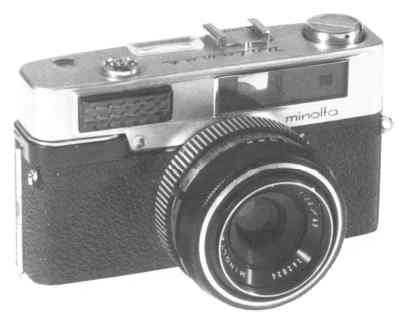
(1960) This was a basically an improved version of the Minolta Autowide -- with a not-as-wide 45mm (f2.8) lens. It has a built-in, coupled selenium meter, like the Autowide, but with a twist. On the Uniomat, the blades of the aperture and shutter were combined -- hence the name, 'UNI-omat". It provided match-needle, manual exposure, with a meter read-out on the top of the camera. The meter was marked in EV units which were dialed in to a ring on the lens -- and provided metered-manual-programmed exposures -- from f16 at 1/1,000 to f2.8 at 1/8. With the combining of the aperture and shutter blades, the camera set both at the same time -- as the photographer manually dialed in the EV number on the top of the camera. Cold flash shoe. Rangefinder focusing. Very innovative, at the time, and a good seller. It was so popular, it was sold by Ansco as the Anscoset.

(1960) It's the same camera as the Minolta Uniomat, but sold by Ansco as the Anscoset. This was the beginning of a series of Minolta cameras being sold under the Ansco name -- only in the US.

(1961) 45mm (f2.0) lens. Has speeds of B, 1-1/1,000 shutter. Selenium meter. It's basically an A5 with a built-in meter.
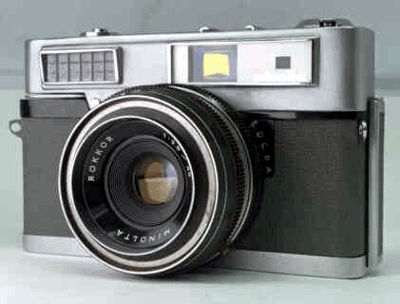
(1961) A year after the introduction of the Uniomat, Minolta made an updated version, but the differences are very minor cosmetic changes which "lighten up" the body slightly. It is only marked "Uniomat" on the camera, but "Uniomat II" is on the box and the owner's manual.

(1961) Same as the the Uniomat II.

(1962) Although this camera looked the same as previous Minolta rangefinders, it was radically different. For the first time, Minolta was offering a camera with true automatic exposure. This camera was available with a 45mm (f2.0) lens or a 45mm (f2.8) lens. It has a built-in selenium meter (EV 8 - 16) that provided programmed automatic exposure of both the aperture and shutter speed from 1/30 at f2.8 to 1/250 at f16. It also offered limited manual exposures setting for flash use -- at 1/60 the f-stops could be set manually. There is even a B setting for timed exposures. Built-in coupled rangefinder, self-timer, cold flash shoe, cable release, tripod socket and PC contact. Film speeds of ISO 6 - 1600. 40.5mm filter threads. The body is covered in light grey leatherette, which makes it stand out among all other Minolta rangefinders. Another strange feature is the shutter release location -- is on the front of the camera, not the top -- which some mistake for the self-timer. It is threaded for a cable release on top -- in the usual place. The Hi-Matic can be found with both "Chiyoda Kogaku" or "Minolta" engraving, since Chiyoda changed their name to the Minolta Camera Co. in 1962. It is often reported that the Hi-Matic was the first camera in space, but this is just another example of poor journalism. In fact, it was an Ansco Autoset (see below).

(1962) Easily confused with the Ansco Anscoset (above), the Ansco Autoset is different -- but it is the same camera as the Minolta Hi-Matic -- with a few very minor cosmetic changes, for some reason. This camera is respected for being the first camera used in space! John Glenn brought a heavily modified one aboard his Friendship 7 spacecraft. The camera is still on display in the Smithsonian Museum in Washington, D.C.

(1962) This was Minolta's attempt to break into the half-frame market. The attempt would last for two years. This version has a 30mm, manually-focusing (f2.8 - 16.0) lens. Close-focusing to two feet! A selenium meter on the front of the camera displays "match-needle" exposure information in a window on the top of the camera. Shutter speeds of 1/30 - 1/250, plus B. The exposure system is similar to the Canon Demi and Konica Eye. The aperture and shutter speed are controlled together by turning a single ring. At one end of the scale, the camera sets 1/30 at f2.8. Turning the ring all the was produces 1/250 at f16. On the Canon Demi, it displays the f-stop and shutter speed. The Repo displays EV numbers, instead. While this makes manual setting more difficult, it makes things easier if you have a hand-held meter with an EV number readout. Built in cold-shoe and PC contact. For flash use, a separate aperture scale is used which sets the shutter speed to 1/30. The exposure ring also has a "B" setting which sets the f-stop to f2.8 -- great for long exposures. Tripod socket and cable release socket. Available in chrome or black versions.

(1963) The Hi-Matic 7 is was an updated and improved version of the original Hi-Matic. Whatever happened to the Hi-Matic 2 through 6? We'll probably never know, except that there was a Hi-Matic 5 (see below). Anyway, the Hi-Matic 7 has a faster, 45mm (f1.8-22) lens with six elements in five groups, extended shutter speed range (1/4 - 1/500, plus B), and a much improved metering system. It dropped the selenium meter and moved to a CDS type (EV 5.7 - 17). To top it off, it was the first Japanese camera where the CDS meter was placed within the filter ring of the lens. This lets the camera "automatically" adjust the exposure for any filters that are used. The camera provided programmed automatic exposure, like the original Hi-Matic, but this model added complete metered-manual exposure with the convenience of the EV system. The EV number that the meter recommended is displayed in the viewfinder. The photographer then transfers this number to the EV setting on the lens. This sets both the shutter speed and the f-stop at the same time. No wonder it was so popular. Built-in parallax-correcting viewfinder with super-imposed rangefinder, self-timer, cold flash shoe, cable release, tripod socket and PC contact. Film speeds of ISO 25 - 800. Takes a 625 battery. 55mm filter threads.

(1963) Not to be confused with the "already-confusing-enough-on-its-own", A2L, this model is very similar to the AL, but has a slower top speed of 1/500. Maybe that was somehow related to its slightly faster 45mm (f1.8) lens. It is marked AL-2 on the top plate.

(1963) This is an "updated" version of the Repo that came out one year later. Both models are simply labeled "Repo" and have the same features -- and are nearly identical in appearance. The original model has a frame around the viewfinder and the selenium cell, while this updated version did not. The top plate on the original was raised slightly just above the meter, while this updated version is flat across the top with a depression for the flash shoe.

(1964) 45mm (f2.8) lens. The main difference is that the selenium meter is substantially larger and moved to front of the lens -- so this version looks substantially different -- although it has the same features and operates in the same manner. The main advantage is that the meter is now a BTF (Behind the Filter) meter for automatic filter exposure correction.
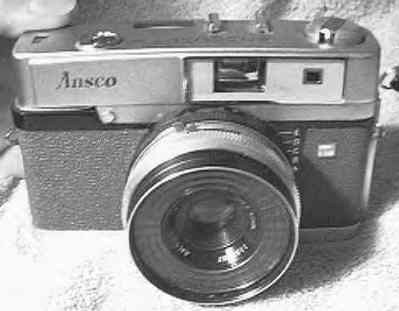
(1964) It's the same camera as the Minolta Uniomat III, but sold by Ansco as the Anscoset III.

(1964) It's hard to know what to call this camera, because it is and isn't a "Repo". The camera is marked "Repo-S" on the top, but the box and manual are marked "Reporter-S". But whatever you want to call it, it is an updated version of the TWO original Repo models. This model came with a much faster 32mm, manually-focusing (f1.8 - 16.0) lens. It still has the selenium-based, match needle system, but with shutter speeds of B, 1/8 - 1/500. This version did not come with a built-in flash shoe -- for some odd reason. Black and chrome versions available. This was the last Minolta half-frame, but certainly not the end of Minolta subminis. They continued to make their popular 16mm cameras, and would go on to make some of the best 110, disc, and APS cameras ever produced.

(1964) You can think of the Minoltina-S as a full-frame version of the half-frame Minolta Repo-S because it looks and operates the same way. Minolta undoubtedly used the name "Minoltina" due to its new diminutive body. It has a Rokkor-QF 40mm f1.8 - 16 lens with close-focusing to 2.6 feet. It adds a rangefinder that the Repo-S lacks, and the Seiko-SLV shutter adds a few slower speed settings (B, 1 - 1/500). Repo-S styled match-needle selenium meter system with needle display on top plate. Just adjust the f-stop or shutter speed rings to get the correct exposure. ISO speeds of 25-800. Like the Repo-S the film wind lever is housed within body. It adds an ASA/DIN conversion scale on back, and a cold flash shoe. It has a tripod socket, cable release connection, PC contact and a 40mm filter thread.

(1964) It's the same as the Minoltina-S, but with a capitalized "AL" and a small "-s". It should not be confused with the Minolta AL of 1961. Perhaps Minolta was using different names for the same camera in different marketing regions, as it did with their contemporaneous SLR cameras -- and many of their even later auto-focusing cameras (ex. "Freedom" in the US vs "Riva" in the EU).

(1964) The Minoltina-P is just a less expensive, simplified version of the Minolta-S. It accomplished this in a couple of ways. Most importantly, it used a wider, slower 38mm (f2.8) lens. This allowed for the removal of the rangefinder -- but the lens still zone-focuses to 2.6 feet. This reduced the weight and cost substantially. And unlike the S and AL-s versions, the P does not allow separate selection of the f-stop and shutter speed. Instead, they are coupled, and a single ring provides 1/30s at f2.8 through 1/250s f22 -- using an match-needle window on the top. For flash use, the speed is set at 1/30s, and apertures are selected.

(1964) This final model of the A5 was an "improved" version of the A5 (model a). It operates the same as the original, and has the same 45mm f2.8 (4/3) lens and shutter (to 1/500 top speed) as the model a, but looks a bit different. On the front, the "Minolta" name is moved up next to the big "M", and the rangefinder now consists of two windows instead of one. On the top, the film advance lever has been moved to the back of the camera, and a hot shoe replaces the cold shoe of the original. It was the last of the original Minolta "A" series cameras, but Minolta would have several later cameras whose "name" starts with an "A". From this point on, Minolta decided that rangefinder cameras needed built-in meters.

(1965) This is a camera that was made by Minolta, but not sold by Minolta. Instead, it was sold by the conglomerate GAF (General Aniline & Film) / Ansco. It bears a resemblance to the other Ansco Anscoset cameras (AKA, Minolta Uniomat), but it replaces the selenium meters with a CDS cell -- located in a separate window next to the viewfinder. The upper window houses the CDS cell; the lower displays the film speed. It comes with 45mm f2.8 Rokkor lens and shutter speeds of 1/30 - 1/500 plus B. It does not have a rangefinder, but the lens is zone-focused with three distance icons that appear in the viewfinder. It has a cold shoe, PC contact, and tripod socket.

(1965) A compact leaf shutter model from 1965 with a Seiko ES programmed shutter. It has a nice Rokkor-QF 40mm f1.8 lens with a rangefinder that focuses to 2.6'. It has a filter thread of 55mm. Exposure is automatic with a CdS cell and film speeds from ISO 25 - 400. It uses one PX-1 battery for the meter and shutter. In fact, this is the first 35mm camera where the shutter and aperture were BOTH electronically controlled. The camera sets the correct aperture and shutter speed (from 1/15 - 1/500). There is no manual mode. Self-timer, tripod socket, cable release connection and PC contact.

(1965) This camera was half-way between the full-frame cameras, and the half-frame cameras. It has a rangefinder-focusing 32mm (f2.8) lens and uses Agfa Rapid cassettes -- which were popular at the time -- for 16 24x24mm exposures (that's right, SQUARE) on 35mm film. So you can't use regular 35mm cassettes in this camera. You have to use Agfa Rapid cassettes. Why were they popular? The idea was to be able to change film more easily, and RAPIDLY -- hence the name. There was no need to connect the film take-up tab to the camera spindle, AND every Rapid cassette had a tab to tell any RAPID camera what the film speed was. Great idea? Yeah, but it was quickly lost when Kodak developed the 126 Instamtic cassette with drop-in easy. The 24 Rapid has a programmed shutter using a CDS meter -- with manual override -- and a flash shoe.

(1966) As the name suggests, the Hi-Matic 7S is an updated version of the Hi-matic 7. It has the same body as the Hi-Matic 7 as well as the same 45mm (f1.8-22) lens and shutter speed range (1/4 - 1/500 plus B). What was different about the Hi-Matic 7S was that a hot shoe, a film-load indicator, and the CLC exposure system (made famous by the Minolta SRT101 SLR camera of the same year) were added to the camera. Like its predecessor, it has both manual and automatic exposure modes. Auto-exposure is a programmed setting where the camera selects both shutter speed and aperture. There is an EV readout in the viewfinder to set the exposure manually with EV settings on the lens. It has a parallax-correcting viewfinder with a super-imposed rangefinder; tripod socket, cable release connection, self-timer, hot shoe, and PC contact. Film speeds from 25 to 800. The lens has a 55mm filter thread and close-focusing to 3 feet. Available in chrome or black. Takes a 625 battery.

(1966) An updated version of the Hi-Matic 7S with the same body as the Hi-Matic 7S. It has a slightly faster 45mm (f1.7-22) lens with a new GN (guide number) feature. Focusing the lens in flash mode automatically sets the correct f-stop for the flash. No need to do any calculations. Just dial in the GN of the flash and let the camera do the work. Minolta called it "Easy-Flash". Takes a 625 battery. Parallax-correcting viewfinder with super-imposed rangefinder. 55mm filter thread and hot shoe.

(1966) Fast, six-element, 40mm (f1.8) lens. It should not to be confused with the Minolta AL. It is an ungraded version of the Minoltina-S/Minoltina AL-s of 1964 -- with the addition of a CDS meter and a hot flash shoe.

The Minolta AL-F appeared in 1967. This is a very full-featured camera and easy to use. It has a 38mm (f2.7) focusing lens. It's a shutter-priority, auto-exposure camera. Just pick the shutter speed and the camera selects the correct aperture from f2.7 - f22. There are no manual exposure settings. The selected f-stop is visible on a scale in the viewfinder as are over- and under-exposure marks. The viewfinder is parallax correcting. Hot shoe, rangefinder focusing, tripod socket, cable release connection, PC contact, and CLC CDS metering are all built-in. The camera also has a GN (guide number) lens for flash use -- hence the "F" in "AL-F". Minolta referred to it as "Easy Flash". Just dial in the guide number of the flash unit (from 32 - 180 in feet), and the camera sets the correct aperture based on the distance from the camera to the subject. To use the GN flash, the shutter speed dial is set to a "lightning bolt" symbol. After the GN for the flash is dialed in, the subject is focused and the correct f-stop is automatically set -- no more cumbersome calculations. The shutter has speeds of 1/30 - 1/500 sec plus B. The lens has close-focusing to 2.6 feet and a 46mm filter thread. It takes one 625 battery. Film speeds from ASA 25 to 500.

(1968) 40mm (f1.8) lens. Basically like a Minolta ALS but with the CdS meter BTF (Behind-the-Filter). Shutter speed from 1/15 to 1/500. Like the ALS, it has an f-stop readout on the top, and a hot shoe.

(1969) Minolta thought of the Hi-Matic 11 as an updated, and improved version of the Hi-Matic 9. In fact, it is just a more automatic version of the Hi-Matic 9. It has the same body as the Hi-Matic 9 and the same 45mm (f1.7-22) lens with almost the same shutter speeds -- 1/8 to 1/500, plus B. What's different is that the manual mode is removed -- even for flash mode. The aperture ring is removed, so you can't even set the f-stop in flash mode. The camera uses a GN lens instead. And instead of manual mode, the camera added shutter-preferred exposure mode. It is engraved ‘Super 3 Circuit,’ which refers to the triple exposure modes: shutter-priority automatic, flash guide number automatic, and programmed automatic. Parallax-correcting viewfinder with super-imposed rangefinder. The selected exposure mode is seen in the viewfinder by means of a tiny mirror reflecting off of the exposure mode control ring. One other change was the dropping of the EV numbers in the viewfinder. The readout in the viewfinder now shows the f-stop, but this is just the setting that the camera will make, as they cannot be set manually. Takes a 625 battery. Hot shoe, cable release connection and tripod socket. 55mm filter thread.

(1969) This camera has a new, small body -- hence the designation "C" for "compact. In order to make the camera smaller something had to go. First, the lens has a shorter focal length and has a smaller maximum aperture -- 40mm (f2.7-16) lens. Second, Minolta made it a collapsible lens for extra compactness (when not being used, anyway). To save even more space, the rangefinder was dropped. The lens has a simple three click-stop, zone focus lens using distance icons on the lens which reflect into the lower right corner of the viewfinder. The shutter was made smaller by having only two shutter speeds (1/30 and 1/250) which are selected by weather icons -- SUNNY or CLOUDY. The camera uses shutter-preferred auto-exposure only -- no manual mode -- with a needle & f-stop display in the viewfinder -- but some manual operation can be performed by using the "FLASH" mode or changing the ISO. The camera kept the "Easy-Flash" guide number (GN) system of its predecessor. When using a flash (or not), the shutter is set to 1/30 and you dial in the Guide Number -- 14 to 56 -- essentially selecting the f-stop. The body and frame are largely plastic with a metal top cover. The Hi-Matic C is very small and light, and despite it's shortcomings it has a hot shoe, cable release connection, PC contact, and tripod socket. Film speeds of ISO 25 - 400. Takes a 675 battery for the behind-the-filter CDS meter (EV 7.9 - 17). 49mm filter thread.

(1969) This is basically a Hi-Matic C without the collapsible lens. 40mm (f2.7-22) lens. Scale focusing to three feet, but without a viewfinder readout of the distance. A CDS meter provides shutter-preferred, auto-exposure -- with an aperture readout in the viewfinder. The two shutter speeds (1/30 and 1/250) are selected by two weather icons, and the camera then sets the f-stop from f2.7 to f22. Film speeds from ISO 25 - 400. Takes a 675 battery. 49mm filter thread. Hot shoe, cable release connection and tripod socket. The camera kept the "Easy-Flash" guide number (GN) system of its predecessor. The camera is surprisingly light due to the high percentage of plastic parts.

(1969) It's the same as the Hi-Matic 5 but the logo is changed to include the name "JC Penney" on the body. And, you guessed it, you could only buy it through JC Penny.
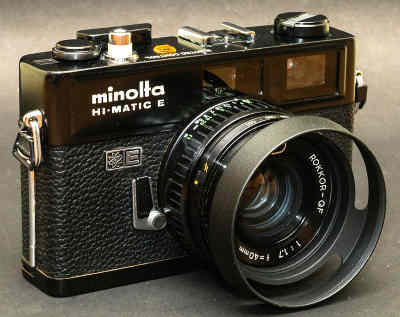
(1971) In many ways, the Hi-Matic E was a giant leap forward. It offered a convenient, fully-automatic exposure camera with a very fast lens in a small, compact body. It was loaded with features like a fast 40mm (f1.7 - 11) lens with six elements in four groups, parallax-correcting viewfinder with super-imposed rangefinder; tripod socket, cable release connection, self-timer, guide number (GN) lens, and more. It's main drawback was that it lacked a manual exposure mode. Exposure is programmed automatic only, using "Electro Control" which Minolta purchased from Yashica and was used on the numerous Yashica Electro cameras. It was an electricity-sucking exposure system that does more than meter the scene. It sets the aperture and shutter speed (1/1,000 - 2 seconds) electronically with the same set of blades, which explains the use of two large, expensive 640 batteries. So without a battery, you can't take a picture with this camera. Despite this shortcoming, it is reported to be an excellent compact camera: small, quiet, and sharp. It used a newer, super-sensitive CDS metering system (EV 0.5 - 17) that was behind-the-filter, with ISO settings from 25 - 500. It can use a manual or automatic electronic flash with a hot-shoe or PC contact, and adds a "flashmatic" feature that can only fire the flash when it is needed. 49mm filter thread. Chrome and rare black bodies were available.

(1971) A modified Hi-Matic E, it was made for exclusive sale in S.S. Kresge stores -- hence the "S" designation. (Ever wonder where the "K" in K-Mart comes from? It's "K"resge). Takes a 640 battery. 46mm filter thread.
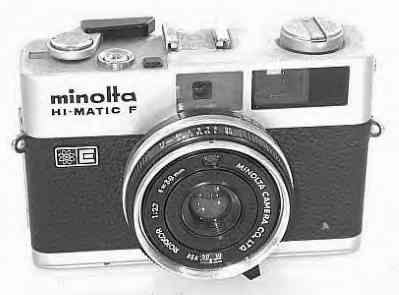
(1972) 38mm (f2.7) lens. It is a less expensive version of the Hi-Matic E with a slower, smaller lens. But it still full-featured. It has close-focusing to 2.6 feet. The viewfinder has a built-in, coupled rangefinder with parallax correction marks. The CDS meter can handle film from ISO 25 - 500 and provides programmed automatic exposure of the f-stop and shutter speed from 1/4 at f2.7 to 1/724 at f13.5. It used the same "Electro Control" exposure system of the Hi-Matic E. Nice and quiet, but requires two large, expensive, 640 batteries. GN lens with 46mm filter thread. It has a film load indicator.

Black model of the F. Why didn't they call it the "Hi-Matic FB"? Don't ask me!

(1972) Another Hi-Matic made for sale by S.S. Kresge stores. Perhaps the CS stands for "compact for S.S. Kresge". It was a smaller, lighter version of the Hi-Matic ES with a shorter, slower 38mm (f2.7) lens. It used the same "Electro Control" exposure system of the Hi-Matic E. Takes a 640 battery. Only available in black, so it's basically a Hi-Matic FP.

(1974) Finally, Minolta got rid of the power-sucking, battery-dependent "Electro Control" system. The Hi-Matic G was not only able to return to a sensibly-sized battery, it is a smaller, lighter, less expensive version of the F with a 38mm (f2.8 - 14) lens and a simpler 4-zone focus lens and no rangefinder. Think of it as an updated Hi-Matic C without a collasping lens, but with a full range of shutter speeds. Despite its small size and limited features, its four element/three group lens is reported to be a quality shooter. It has programmed exposure and a guide number (GN) lens. Built-in hot shoe. Close focusing to 3.3 feet. The CDS meter provides programmed exposures from 1/30 at f2.8 to 1/650 at f14. It displays the f-stop and shutter speed in the viewfinder. Film speeds from 25 to 400. Takes a 675 battery.

(1974) A variant of the Hi-Matic G -- or a copy -- it has the same basic features with some cosmetic changes, as well. Minolta was undoubtedly involved with this camera, but probably we will never know to what extent.

(1974) A variant of the Revue 400 L with a rangefinder and a self-timer. Minolta was undoubtedly involved with this camera, but probably we will never know to what extent.

(1974) A variant of the Revue 400 S, it has the same features, as well. Minolta was undoubtedly involved with this camera, but probably we will never know to what extent. It's possible that this is the first collaboration between Minolta and Konica -- that would lead to their eventual merger, 25 years later, in 2003.

(1974) Another variant.

(1974) And yet another variant.

(1977) Many consider this to be the top-of-the-line Minolta rangefinder. And it's no wonder. It packs a 40mm f1.7 lens into a very compact body -- with full-features. It has shutter-preferred automatic exposure and full manual mode, as well. Hot shoe, self-timer, rangefinder-focusing. And did I mention an f1.7 lens with a 49mm filter thread? Chrome and black versions available. Takes a 675 battery. There were three clones of the 7SII (see below) marketed by other companies and perhaps manufactured by other firms. It's difficult to know what parts of these cameras, if any, were made by Minolta. Perhaps Minolta made everything for all of the cameras, perhaps they just made the 7SII, or perhaps they made the lenses for all of the cameras. We'll probably never know.

(1978) Exactly the same as the Hi-Matic 7SII (model a), but the focusing lever is three times as big. It's now about the size of your finger tip, and much easier to find and use.
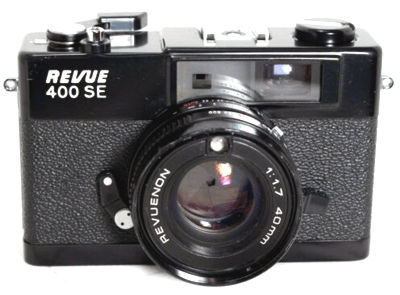
(1978) The Revue 400 SE is a modified Minolta Hi-Matic 7SII sold by Foto-Quelle, a German photographic marketer (which sold other Minolta cameras over the years). There are several differences between the two cameras, but most of them are completely cosmetic. The most obvious difference is that the lens is marked "REVUENON", and not "ROKKOR". In addition, while the Hi-Matic 7SII has two focusing scales (one for feet and one for meters, on either side of the lens), the Revue 400 SE only has the meter scale -- placed on the top of the lens. The Revue lens has the 1/125 setting marked in red, unlike the 7SII. In addition, the Minolta lens has a chrome (painted) ring around the distance scale, while the Revue is all black. The two bodies also have differences. First, and foremost, the Revue has a PC contact in addition to the hot shoe -- a feature that would have been nice on the Minolta. The corners of the camera body are more square on the Revue, but you'll have to look close to notice the difference. There is a small ridge around the viewfinder and rangefinder on the Revue (which the Minolta lacks), and the Revue lacks a metal strip separating the two (which the Minolta has). The film advance lever has a shorter plastic tip than the Minolta, and the camera strap lugs are placed higher up on the body. The f-stop display in the viewfinder is slightly smaller in the Revue, the focusing lever is smaller, and the film counter has a mask. Internally, the take-up spool is slightly different, as are the film plane guides. Overall, the differences between the Revue 400 SE and the HI-Matic 7SII are very minor, except for one significant change. The Revue dropped the manual aperture settings of the Minolta, and added a GN (Guide Number) feature to the lens in its place. That's right, the Minolta f-stop dial is replaced with a LZ (Guide Number 7-56) dial on the Revue. Taken together, there are enough differences to say that these are different cameras, but there are enough similarities to say that they are the same. We'll let you decide. Pick the one that has the feature you need most -- manual exposure control or a guide number lens! Better yet, get one of each. The Revue 400 SE is harder to find than the Hi-Matic 7SII, but it can probably be had for a lot less money than the original. So far, we have seen it only in the black version, but it might be available in chrome as well.

(1978?) A variant of the Revue 400 SE sold by Foto-Quelle.

(1978) The Vivitar ES is either a modified Revue 400 SE or a modified Minolta Hi-Matic 7SII, depending on how you look at it. As with the Revue, we can't tell if Minolta made the entire camera, the shutter/lens assembly, just the glass for the lens, or none of it at all. Also like the Revue, it's features are more like the Konica Auto S3 than those of the Minolta 7SII.

(1978) This was designed as an auto-everything camera -- that is, as automatic as can be without automatic-focusing. It has a Rokkor 38mm f2.7 (4 elements in 3 groups) with 5-zone focusing, from 31 inches to infinity. The lens uses distance icons instead of feet/meter markings, but these are pretty comfortable. These icons also appear in the viewfinder, so you never have to remove your eye from the viewfinder. Automatic exposure only -- even with the built-in pop-up flash (which is the main difference from the previous Hi-Matics). Think of it as a Hi-matic G with a built-in flash. The placement of the flash necessitated that the rewind knob be moved to the bottom of the camera. When the built-in CDs meter senses that the slow shutter speed is needed, an LED lights up as a warning in the viewfinder -- i.e., blurred photo, TURN ON FLASH -- which can be activated by a lever under the flash -- which pops up. A scale on the back of the camera gives the distance range for a given ASA film rating when the internal flash is deployed. Programmed shutter speeds from 1/4 at f2.7 to 1/450 at f17. Film speeds from 25 - 400 with an EV range of 4 to 17. Flash guide number of 14 (meters) with ASA100 film and 27 with ASA 400 film. Takes two AA batteries -- thanks to the flash. A very easy camera to use. No flash shoe or PC contact, so you are stuck with the built-in flash, but it does have a tripod socket.

A variant of the Hi-Matic S, it has the same basic features with some cosmetic changes, as well. Minolta was undoubtedly involved with this camera, but probably we will never know to what extent.

(1978) The same as the Hi-Matic S with a date back -- hence the "D" -- and a self-timer, of course, so you can get in the picture. The "bump" on the top is the date imprinting operator. Takes two AA batteries.

(1978) Similar to the Hi-Matic S, not the CS, and not often seen.

(1981) Slightly modified Hi-Matic S with a 38/2.8 zone focusing lens. The most noticeable change is that the model name is removed from the front. Close-focusing to 2.6 feet. The CDS meter has an EV range from 6 to 17 and sets the f-stop and shutter speed in a programmed auto-exposure mode from 1/8 at f2.8 to 1/430 at f17. Film speeds from ISO 25 - 400. Built-in flash provides about 250 exposures and illuminates the focusing ring when turned on. There are visual (LED) and audible signals to indicate that the flash is needed. The shutter locks if the batteries are low. The lens is marked Minolta, not Rokkor and the camera takes two AA batteries. No cable release connection for some reason.

(1981) It's the same as the Hi-Matic S2 with a date back, hence the "D", but for some reason it was not called the "S2D". The self-timer is somewhat different in appearance.

1973-1975. A collaborative camera with Leitz, the CL was designed by Leica in Wetzlar and made by Minolta in Japan. Minolta and Leica always had a love-hate relationship, with Minolta loving Leica cameras and designing several cameras after the Leica models (see above) -- and Leica hating the market share that Minolta was taking away from them. And as production costs continued to rise in Germany, Leica looked for ways to cut costs while expanding their market share. Leica decided to produce a compact Leica (CL) camera that would be less expensive than their existing models. But in order to keep production costs down to a minimum, they needed the camera to be manufactured by an outside company with hi-tech capabilities and low labor costs. They were able to reach an agreement with Minolta, and the CL was born. It's basically a miniaturized Leica M3 with the same bayonet mount. But what made the CL different was the built-in behind the lens meter! A thin lever, with a metering cell on the tip, slid down in front of the film-plane in order to take meter readings. At the instant of the exposure, it flipped up, and out of the way. Originally, the lenses were supplied by Leica, but things evolved over time, and Minolta eventually made the lenses. The CL was sold in different markets, at different times as the Leica CL and the Minolta CL. Under the manufacturing agreement with Leica, Minolta was allowed to sell the new CL -- in Japan -- as the Leitz-Minolta CL. All of these variations were the same exact camera, but the supplied lens might be a Leica or a Rokkor. This leads to a lot of confusion. The major features include shutter speed and metering information displayed in the viewfinder, built-in rangefinder, interchangeable lenses, hot shoe, compact and lightweight. Sure, it lacked the auto-exposure of the CLE (see below), but it has a full range of shutter speeds (1/1000 to 1/2, plus B). It has a vertically-styled shutter, similar to the Minolta XE-7 (which was also a collaboration with Leica), but the shutter in the CL is completely battery FREE!

(1981) When Leica ceased the production of the CL in 1975 (which was actually made in Minolta's factories), Minolta was free to change the CL, and so they improved it to make the CLE. And this time they completely dropped the Leitz from the name. It was slightly larger than the CL, but boasted TTL metering with both automatic and manual exposure modes. The nifty metering arm of Leica CL was replaced by rearward-facing, silicon metering sensors that measure the light falling on the film, a bit like one of the Olympus OM cameras did it. The other clever bit is that the shutter curtain has a silver/black pattern on it so it reflects like the film does, so the camera can meter before and during the image exposure -- should the light change! The addition of automatic exposure was a major improvement to the design, although the shutter is now battery dependent. In addition, because it was now a silicon metering cell, the camera was able to offer TTL flash mode -- an incredible breakthrough in camera features at that time. This feature would appear on later cameras -- both Minolta and not. The interchangeable lenses are basically the same, but a 28mm (f2.8) lens was added to the line-up. The camera also has a self-timer and hot shoe. Most cameras were in black, but a limited edition gold version was made to celebrate Minolta 3,000,000th camera. At the time, people thought of it as a miniature Minolta XE-7. It has the same basic features -- more or less -- and the same beautiful feel of XE-7. Nowadays, people think of it as a miniature Minolta X-570. It has the same basic features -- more or less. While it lacks the SLR design, it has the same TTL flash.

(1982) This is an updated version of the Hi-matic G. It has the same 38mm zone-focusing lens with f-stops from f2.8 to f22 with four elements in three groups. Close focusing to 3.3 feet. The lens has four focusing icons -- with click-stops for easy operation -- but also has distances markings for feet and meters. The lens has a 46mm filter thread and a behind the filter CDS meter. The change from the Hi-matic G is that the body of the G2 is even smaller and lighter -- and it only came in black. The CDS meter has an EV range from 9 - 17 and controls the exposure with a programmed auto-exposure system setting the aperture and shutter speed from 1/60 at f2.8 to 1/250 at f22. Film speeds of 25-400. X synch at all speeds. Takes a 675 battery. It's the smallest full-frame, manual focus camera made by Minolta, but still a quality shooter. The camera is very small -- just a little bigger than the Repo half-frame models -- and very light (just 10 ounces), but without a cheap feel to it. With a tiny Vivitar 50 hot-shoe flash (a perfect fit), the G2 makes a very tiny package. However, the G2 is missing a couple of things that would be nice. It has a tripod socket, but it lacks a B setting and a cable release connection. So no long exposures with this guy. In addition, it also lacks a battery ON/OFF switch, so a lens cap or camera case is important for battery longevity. Unfortunately, it uses a 1.35 volt 675 battery, but appears to be relatively accurate with a 1.5 volt 675 battery. One nice thing about the camera is that it operates fine without the battery. Normally the meter sets the shutter speed (from 1/60 to 1/250) and f-stop (from f2.8 to f22) in a programmed auto-exposure mode, but without the battery, the shutter defaults to 1/60. The f-stop can be set from f2.8 to f11 by adjusting the GN dial. That's a nice touch because you can always take pictures. The GN lens is not like the GN lenses I have seen. With the G2, the aperture is set -- and fixed -- when you dial in the GN of the flash -- and is intended to expose a subject at around 10 feet away. The exposure will be OK from about 7 feet to 17 feet, but the f-stop does not vary as the lens is focused -- like all of the GN lenses I have seen. The G2 GN approach works, and allows you to set the f-stop manually, but it has its limitations. Fortunately, the G2 uses a trap-needle system. That allows you to meter one part of the scene, press the shutter release partially (which traps the needle), and then expose a different scene. It operates like the AE lock on SLR cameras, but is not mentioned in the owner's manual. So even though the camera lacks manual exposure settings, you can control the exposure fairly easily. First, you can use the trap needle method. Second, you can also take the camera off of AUTO and use the GN numbers (without a flash). This fixes the shutter speed to 1/60, and by changing the GN numbers, you can select the f-stops from f2.8 to f11. Not bad for a "cheap" camera. I look at it like a baby brother to the 7SII. Sure, it lacks the f1.7 lens and the rangefinder focusing, but it has most of the other features -- in a tiny, lightweight, all black package.
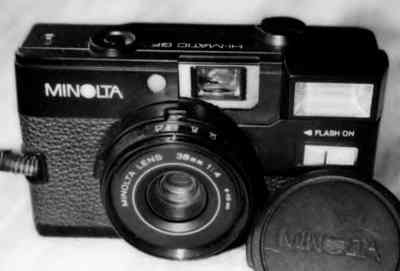
(1984) The Hi-Matic GF is the last, and simplest, camera in the Hi-Matic series -- a very light, plastic, uncomplicated, and pocketable camera -- but with lots of possibilities. It's barely larger than the Hi-Matic G, but it includes a built-in electronic flash -- and room for TWO AA batteries. How did Minolta do it? Something had to give -- and it did. It has a rather slow 38mm f4.0 (3/3) Minolta (not marked Rokkor) lens. This slower, simpler lens has its advantages. First, a rangefinder is no longer needed, but the lens does have 4-zone focusing -- from infinity to 3.3 feet using icons. There are three aperture settings -- Waterhouse stops -- f4, f8, f16 (using weather icons). This makes the construction of the camera simple and inexpensive. It also has a built-in flash powered by two, easy-to-get, AA batteries. It is a manual-only flash that has a GN of 36 (ISO 100 in feet) -- so it's pretty powerful for its small size. So the hot shoe of the Hi-Matic cameras is no longer needed. The mechanical, leaf shutter is fixed at 1/125 second. Film advance is by a wheel, not a more common thumb lever. The camera was designed to be used with ISO 100 & 400 speed film, but other films can be used, of course. There is a small switch on the lens to select ISO 100 or 400 speed film. This lever does not change the f-stop, as you might expect, but it does control a red, LOW LIGHT/USE FLASH indicator light on the RIGHT side of the viewfinder. With ISO 100 film, on sunny days, f16 is perfect. Cloudy? Use f8. In the shade? Use f4. Indoors? Use the flash -- which is turned ON by a small lever under the flash -- which pops UP. That sets the aperture at f4, and an orange ready light illuminates to the LEFT of the viewfinder when it is ready. The flash is good for ISO 100 to 12 feet and ISO 400 to 20 feet! Quick and simple. There is a distance scale for the flash range on the bottom of the camera. PLUS, it can be used without batteries if you keep in mind the f-16 rule. Not sold in the U.S.A.. Great to use in places where you don't want to risk your quality camera, but still want great results -- and need some control of the exposure. The GF even has a tripiod socket.

(1984) The Freedom I is often assumed to be Minolta's first autofocus camera, and while it is the first in the Freedom series, it is not an auto-focus camera. Although it looks the same as the later, auto-focusing, Freedom II and III cameras -- which are auto-focus -- the Freedom I has a fixed-focus lens. It sports a 35mm f4.5 lens with four elements in four groups, and has a depth-of-field from 5 feet to infinity (at a minimum). It has programmed automatic exposure from f4.5 at 1/50 (in low-light) to f17 at 1/250 (in bright light) using a silicon photocell (EV 10 - 16.2). Automatic DX film coding from ISO 100 to 1000, plus manual film settings of 100, 200, and 400. Add to this a built-in auto-exposure flash and automatic film advance & rewind. The flash automatically fires in low light. If you depress the shutter release button slightly, a red light in the viewfinder will light -- if the flash is needed -- but not ready to fire. In this case, just give the flash a couple of seconds to charge, and try again. The flash is powerful enough up to 10 feet with ISO 100 film, and up to 25 feet with ISO 1000 film. If you want a simple camera with good quality, this it it. Just drop in the film and take pictures. It even has a built-in lens cover, so it is pretty self-contained. The Freedom I uses two easy-to-get, AA batteries and has a window on the back so you know what type of film you are using. A filter (UV?) , a tele converter, a close-up converter, and a case were accessories from Minolta. Other companies made wide-angle and telephoto converters, to make this a very flexible camera. Also sold in some countries as the FS-E (below).

(1984) Sold in some countries, it is the same as the Freedom I (above), but unlike the Freedom I, the name is not on the front -- it is on the top!

(1985) A similar, simpler version of the Freedom I. It has the same 35mm f4.5 lens, but only has speeds from 1/40 to 1/150. The DX coding can handle only ISO 100 and 400 films. The built-in flash automatically turns on when the camera senses a low light situation. Auto winding and rewinding. The camera uses two AA batteries. It's the same as the FS-E II (below).

(1985) Sold in some countries, it is the same as the Freedom 100 (above) -- and the name is now on the front!

(1987) Same as the Freedom 100, but with an added self-timer and a blinking LED on the front.

(1987) Same as the Freedom 101.
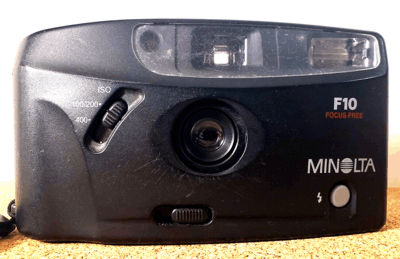
A simple, fairly large, but easy-to-use camera with a built-in flash and a fixed-focus lens. It has a built-in CDS meter that sets the exposure and flash. There is a button on the front, conveniently located, to press for fill-in flash use. There are two ISO settings: 400 and 100/200 that are selected on the front of the camera. No tripod socket, no cable release connection, no self-timer. Just bare-bones simplicity. But it does have a wrist strap, a built-in lens cover, and automatic film advance and rewind. Uses two AA batteries. Made in China.

It's a simplified version of the F10 -- if you can imagine that! -- in the same body. The ISO selector and flash fill-in flash button on the front are gone -- but it has a quite big finder (not bigger), hence the BF in the name. The camera features an auto-operated flash with red-eye reduction, a green LED in the back to confirm proper exposure, auto DX encoding, and motorized film transport and rewind. A sliding lens cap switches power and protects the lens. The camera is operated by 2 readily available AA batteries.

A variation on the F10 -- once again, just bare-bones simplicity. The aperture is fixed by the ISO setting on the front -- looks like f5.6 at ISO 100/200 and f11 at ISO 400. The shutter speed does not appear to vary, so the only exposure adjustment is the flash firing or not -- controlled by the CDS cell, and the fill-in flash button on the front.

Similar to the F10BF, but in a slightly different body. The camera features an auto operated flash with red-eye reduction, a green LED in the back to confirm proper exposure, auto DX encoding and motorized film transport and rewind. A sliding lens cap switches power and protects the lens, the camera is operated by 2 readily available AA batteries.

(1994) The Minolta F20R has a new, more compact body, basically a fixed focus version of the AF 101R. The "R" in the model name stands for "red eye reduction", which is done by a separate lamp near the flash, which may be permanently disabled by a switch on the front. It has only one shutter speed, and has a DOF of 5' to infinity -- thanks to its 28mm f/5.6 lens. The shutter is fixed at 1/125s. The built-in flash is automatic with anti-red eye lamp, but can be set for fill-in flash or flash-off modes with a switch on the face. The range is 5-9 feet. It has a flash-ready LED signal. Film speed: DX coded films for ISO 100–400 -- non-DX films are exposed as ISO 100. Automatic film loading and advance, and manually activated motor rewind. Powered by two AA batteries. A CR2025 cell is used in the optional date back version. It was also available in an auto-focus version -- the AF 101R.

The Minolta F25 made several changes -- most noticeable is the body. Next is the lens -- a slightly slower, 35mm optics with a fixed aperture of f/6.3. This gives a DOF range of 4'- infinity -- and the viewfinder has frame lines with parallax markings. The F25 has a fixed shutter speed of 1/125. The camera automatically triggers the built-in flash when light falls too low. This has a range of 4'-8'. The camera has DX coding allowing it to use 400 ISO and 100/200 ISO film. The camera has motorwind but for rewinding requires manual use of a switch on base. It is powered by 2 AA batteries. A data back version was available, powered by a CR2025 battery. The Minolta AF25 is the same camera, but with autofocus.

(1989) Basically the same camera, but in a new body style. The lens is the 35mm f4.5 (for flash) and f8 (for sun) and a mechanical shutter fixed at 1/125s. LED indicator for low light and flash ready signal. Film speed for DX coded films is ISO 100 or 400. Non-DX film is exposed as ISO 100. Automatic advance and rewind. Uses two AA batteries. It is the same as the FS-35.
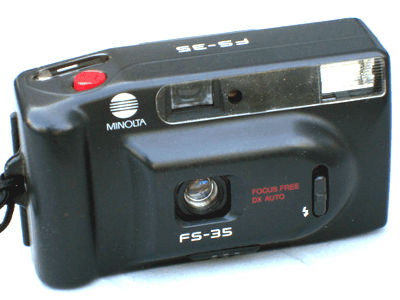
Same as the Freedom 50.

A simple, fixed-focus camera with built-in flash. Built-in meter sets exposure and flash.

(1991) A follow-up to the Freedom 50 in a different body style. Same features. A dateback version and an auto-focus version were also available.

(1991) It's the same as the Freedom 50N. A dateback version and an auto-focus version were also available.

(1992) A successor to the Minolta Freedom 50N. Its main additions to its predecessor are variable shutter speeds, a self-timer, and a dateback. It has a mechanical shutter with speeds from 1/35–1/100s. Apertures of f4.5 for flash, and f11 for sun. Film speed is DX coded from ISO 100 to 400 and non-DX films are exposed as ISO 100.

(1992) It's the same as the Freedom Holiday, but sold in countries that don't have holidays. The "ST" is short for "Self-Timer".

An upgrade to the Holiday with a new body style, and the addition of a flash switch on the front for AUTO, FILL-IN, and OFF options.
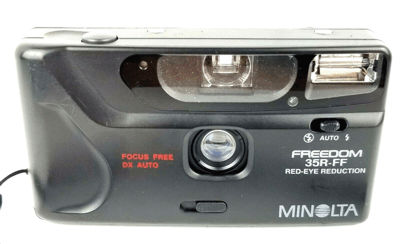
Its the Holiday II with a different name and country.

The Freedom GT is just a cosmetic variation of the Freedom 50N. A dateback version was also available which uses a CR2025 battery.

It's the same as the Freedom GT. A dateback version was also available which uses a CR2025 battery.

A simple, fixed-focus camera with a built-in flash. It has a 35mm f4.5 lens with a DOF range from 5' to infinity. The built-in meter sets the exposure and the flash. A sliding cover protects the lens and also hides the flash activation button. The camera uses 2 AA batteries for power, and film ISO is set by DX decoding between 100 and 400 ISO. A red LED light indicates low light -- which is activated by a CDS cell.

In a flash-back to the F10 and F12 models, this version has the ISO setting on the front, and the PRESS AND HOLD button on the front for fill-in flash use.

(1998) The Minolta Memory Maker III is a fixed focus camera with a 35mm f/5.6 lens for a DOF range of 6' to infinity. It has a single shutter speed or 1/125 sec. and DX ISO setting of 100/200 or 400. The flash range (ISO 100) is 6'-9'. It uses 2 AA batteries, and has motorized film advance and rewind.
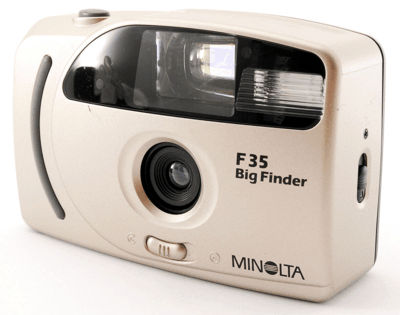
(2000) Simple, fixed-focus camera with extra-large viewfinder for easy viewing -- and labeled "BIG FINDER" on the front. It comes with a wide-angle 27mm f/6.3 lens (three elements in three groups). Great for kids, anyone with impaired sight, or in any situation where you want a fast-acting camera and don't want to risk your more expensive gear. The built-in flash is set by the built-in meter. It has a single shutter speed of 1/100. ISO film setting of 100/200 or 400. Automatic film advance. Uses two AA batteries. Built-in lens cover. It has a built-in flash with red-eye reduction, auto film advance and rewind, and reads DX codes on film cassettes. Also available in an auto-focusing version -- the AF35.

(2000) Just a new body and color-tone.
We didn't want to do this, but since other websites have been stealing our stuff, we have no alternative but
to state:
COPYRIGHT@1995-2026 by Joe McGloin.
All Rights Reserved. The material on this website is protected by US Federal copyright laws. It cannot be copied
or used in any manner without specific approval from the owner.